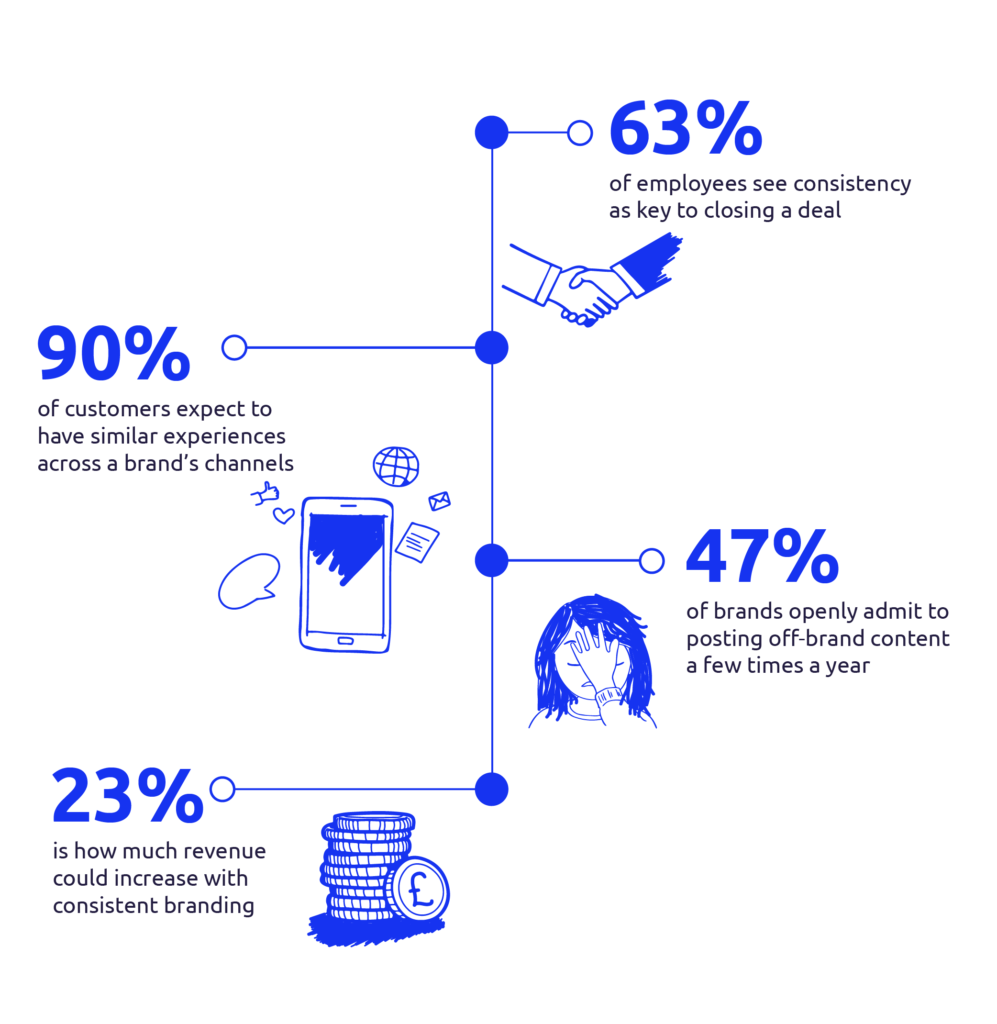
Brand governance made easy: how to stop correcting your team and start empowering them
When you’ve spent time and money creating a strong brand, it’s only right that you use it across every channel. Doing so means potential customers recognise you at every touchpoint while building trust.
If you aren’t consistent with branding, you risk confusing customers with disjointed experiences. It’s hard for them to recognise you and undermines your brand reputation if they do.
Achieving consistency means bringing everyone in your organisation onto the same page. That is where brand governance comes into action.
For many organisations, this means policing the creation and use of internal assets. It’s as exciting as it sounds.
But what if there was a better way to govern brand? One that kept people engaged and aligned, without marketing having to play bad cop all the time.
This blog explores how to simplify your brand governance for better results and productivity.
- What is brand governance?
- Is brand governance effective?
- Tips for easier, more effective brand governance
What is brand governance?
Brand governance is the process of achieving consistency across your brand assets. It’s how you get people in your organisation to correctly use your branding, including logo, fonts, colours and tone of voice. It might affect all sorts of documents and communications, including invoices, letters, emails, social media, flyers, invitations and so on.
Consistency drives many benefits.

Firstly, it makes you up to 3.5 times more visible, meaning better awareness and sales potential.
Secondly, 90% of customers expect to have similar experiences across a brand’s channels. So, it’s key to meeting customer expectations.
63% of employees also see consistency as essential to closing a deal. It’s no surprise, then, that it can also increase revenue by 23% when done well.
If you don’t maintain consistency, you won’t just damage your brand; you’ll damage performance, reach and trust.
Add into the picture that 47% of brands openly admit to posting off-brand content and it’s easy to see why brand governance is needed.
It’s especially critical in large organisations where multiple people create brand output.
Is brand governance effective?
Although the need for brand governance is clear, the issue lies in how it’s done.
Brand governance is usually left to marketing teams, who need to police everyone else. Typical processes include getting everything signed off before it goes live. Alternatively, some organisations will rely on one person or team to create all brand assets to avoid risk.
Both of these options lead to production bottlenecks, where everyone has to wait for their request to be processed. Marketing becomes overwhelmed with work while other teams face delays. The result is stress and a lack of progress all round.
If organisations do allow non-marketing personnel to create, scrutiny is needed to avoid mistakes. The result is an endless cycle of correcting people. It’s frustrating for the users, who must constantly amend their work and lose confidence. It’s also irritating for marketing, who spend more time looking at other teams’ work rather than their own.

The need for education
Another issue with governing brand in the ways listed above is that it doesn’t educate people. So, long term, you can expect to correct the same mistakes, again and again.
By teaching people about your brand, they’re more likely to create great assets that don’t need amendment.
Sometimes, people believe circulating the brand guidelines is all it takes. However, there’s no guarantee that anyone is going to read, let alone absorb your guidelines. This is especially true if they’re not from a creative or marketing background, or don’t have the time to memorise brand guidelines.
For brand governance to truly work, it needs to be done in a way that engages and educates people. It’s only then will you see better alignment across your organisation and avoid repeated mistakes. Marketing can gradually step away from the role of ‘brand governors’ and focus on strategy instead.
Tips for easier, more effective brand governance
So, what can organisations do to make their brand governance more effective and prevent the pressure on marketing? We’ve got a few ideas:
1. Show, don’t tell
Although brand guidelines aren’t enough alone to keep everyone in brand, they are needed. They clearly present how your brand should be used, so you need to have them in place.
The fatal flaw many marketing departments make is simply giving everyone a link to the brand guidelines and thinking “job done”. But it’s unfair to expect everyone to memorise your guidelines and know what to do with them. It’s also time-consuming.
Rather than telling people what to do, show them. Give them real-life examples that guide their own work.
Your marketing team should set a prime example by being on-brand always. Moreover, your organisation’s leaders need to be doing the same. This will lead the way for everyone else to follow suit, without you having to constantly force it upon them.
2. The right tools
Just under half of all employees believe they haven’t got the tools to effectively enhance their employer’s brand. It’s no wonder that getting people on brand can be so difficult.
You must give your users the resources they need to create consistent brand assets. If not, you risk them using DIY options that are impossible to police (think WordArt or Canva).
A great option for this is creating brand templates that users only need to make minor amends to (such as changing text). The branded elements are locked down (such as colours, fonts and logos) so every piece of content meets your guidelines.
The added benefit is that it’ll become much easier for people to make designs. With less work required, more people will feel comfortable delivering their own output.
3. Focus on education
As we’ve already mentioned, education is critical. Once people understand how your brand should be used, they’re more likely to do it right.
Unfortunately, getting people on brand isn’t an overnight process. There are bound to be mistakes, especially from those who don’t come from marketing or creative backgrounds.
The key is learning from those mistakes. It’s not enough to take a red pen to a piece of work to fix errors. When you come across common issues people make, turn them into a learning opportunity.
Tailored guidance, such as comms or workshops, shows the correct way while engaging people. The result is better informed teams who are less likely to make the same mistake – and more likely to enhance your brand.
4. Invest in a brand management platform
If you’re looking for one solution that addresses the tips above, you need a brand management platform.
They utilise templates that live and breathe your brand guidelines. These templates keep everyone on brand, while being responsive enough to adapt to users’ needs. All your users need to do is select their template type, add in their text and maybe some images. The platform will take care of the rest.
A good solution should be user-friendly, making it easy for people to create assets. Many will also provide guidance that actively educates users and suggests amendments, meaning you don’t have to.
With the barriers removed and your users empowered to make great content, their confidence will grow. Your organisation benefits from increased productivity and brand reach.
How RightMarket makes brand governance easy
If you’re looking for a solution to simplify brand governance, look no further than RightMarket.
RightMarket offers a platform that hosts all the templates your organisation might need. Every template fits your brand guidelines, meaning users follow them without even thinking about it. They simply need to add their text and choose images, and they’ve got great brand assets ready to use.
RightMarket doesn’t just correct users. It educates them by offering suggestions and highlighting where they’ve gone wrong. There’s even a Tone of Voice Assistant to guide their wording and select on-brand, friendly alternatives if they use phrases you’d rather they didn’t.
Plus, RightMarket can provide insight into the common mistakes your users make, which you can use for your internal education strategy.
The result is users who learn how to use your brand, giving them the confidence to create great assets without having to rely on marketing. It also allows them to share your brand widely, without the risk of inconsistencies that damage your reputation.
Rather than having to police your users, you can give them the resources they need to deliver brand assets themselves. Everyone gets what they need to succeed – and marketing can get up to 92% of their hours back to focus on strategic work.
If you do need that reassurance that everything’s on brand, there’s also the option for approval workflows.